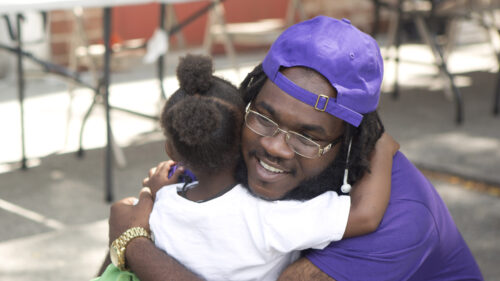Community Justice provides a path forward in divided times.
For far too long, we’ve been told that we must choose between justice and safety, that those two goals are in direct competition. But the reality is that to achieve true justice, we must build safety. And for communities to feel truly safe, there must be justice.
This false dichotomy has ripped a hole in our politics and led to a seemingly endless cycle of extreme approaches to both justice and safety.
In recent years, our political conversation around public safety has been dominated by one side trying to crank up the dial for funding police and punishment with the other side trying to dial it down. But that myopic way of thinking has gotten us nowhere. No one is better off when a community’s desire for both safety and justice is exploited to fuel the partisan divide.
Communities deserve a full-spectrum approach to justice and safety. They deserve solutions based on research and evidence that put the community’s own vision at the heart.

Over our three decades working with communities and courts across the country, the Center for Justice Innovation has honed an approach that fulfills this vision. We call it “Community Justice.”
Community Justice aims to reclaim and reimagine the very concept of the justice system. Rather than focusing exclusively on traditional system actors like courts and police—or, as we’ve seen in recent years, expecting local community groups to deliver safety and justice on their own—we see “the justice system” as encompassing all of the above, from communities to courts and back again.
Among other things, Community Justice reverses the harms of both crime and overreliance on traditional approaches inflicted on communities that have experienced disinvestment, which is so often rooted in racial inequity.
For public safety policies and programs to work, they must be locally-driven, enlisting the support of residents and a wide range of partners. They require long-term planning and commitment. And they require coordination, so that everyone—community groups, law enforcement, non-profits, the business community, government agencies, grassroots leaders, and elected officials—is able to work together toward a common goal.
In our experience, communities embrace Community Justice not only because it works but because it gives them choices. Rather than choosing between more police or fewer, they choose from a variety of flexible strategies that not only respond to crime but take positive steps—like enhancing economic opportunity and reclaiming public spaces—that prevent crime before it happens.
And the best part is that Community Justice can work anywhere—big cities, small towns, and everything in between, across the political spectrum. That’s because Community Justice is focused on what works, putting results over political ideology.
We see Community Justice at work in places like the “Tap In Center” in St. Louis, Missouri, which opened in a county library in 2020 to help local residents get their warrants resolved. The program—a partnership between the county library, the Public Defender’s Office, the Prosecuting Attorney’s Office, the University of Missouri-St. Louis, and the MacArthur Foundation—rebuilds trust between community members and the criminal justice system while providing services like temporary housing, clothing, and food assistance. About 90% of nearly 900 people who have had their warrants resolved through the program have not returned to county jail.
Community Justice also looks like the Downtown Community Court in Spokane County, Washington, a red county in a blue state. The court operates out of a public library to transform the lives of people who repeatedly commit low-level crimes. Rather than issue fines or short jail sentences of questionable efficacy, the court connects people to services in a more inviting setting. Since opening in 2013, it has knit together a coordinated network of local agencies and service providers to more effectively hold participants accountable while addressing factors that contribute to criminal behavior, with the long-term goal of improving safety and the quality of life for everyone in Spokane. Hundreds of residents have not only completed community service in the neighborhoods where they committed a crime, but also been connected to service providers like behavioral health counseling, healthcare, and housing assistance.

And Community Justice looks like the work my organization is doing in the Brownsville neighborhood of Brooklyn, N.Y., where we run the Brownsville Community Justice Center, an incubator of community-driven solutions to neighborhood challenges. Our team has launched numerous programs in partnership with the community that invite local youth to develop skills in areas of their choosing, including music production, digital media, and tech; initiatives that foster economic opportunities in partnership with local small businesses; and efforts to reimagine and redesign public spaces to make them safer and more inviting to the community. The community justice center also has social workers and case managers who accept referrals from courts and the city’s probation department to provide alternatives to incarceration that reduce recidivism by partnering with local organizations for social services and clinical interventions.
A Community Justice approach addresses the real needs of a community, not the needs declared by remote decisionmakers, who may lack a full understanding of local culture and priorities. In addition to reducing crime, it builds leadership capacity and resources in neighborhoods harmed by historic disinvestment and, often, racial injustice. It strengthens local infrastructure, increasing the likelihood that those who live, work, and invest in these communities can launch and sustain their own new initiatives. And it builds bridges and trust between communities and government, ensuring local voices are at the table when decisions are made that impact them.

Community Justice is not revolutionary, but evolutionary. It builds on resources and assets that already exist in communities, starting with community residents and community-based organizations. But to grow, it requires commitment and investments—from the government and the public and private sectors.
That is why it’s critical for our leaders to set aside the harsh rhetoric and focus on long-term solutions. Our communities deserve that much.
